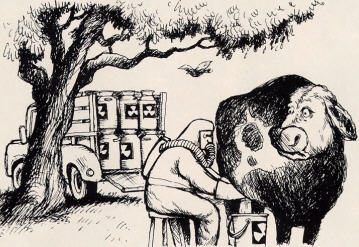Of the thousands of chemicals manufactured, used, or stored in the United States, the U.S. government's Environmental Protection Agency (EPA) lists four hundred three as hazardous. These select substances are either poisonous, corrosive, flammable, or explosive. You can't touch, inhale, drink, or otherwise ingest them without posing a serious risk to your well-being. U.S. industries daily generate more than 1.5 billion pounds of these substances in the form of waste materials. That comes to more than a ton a year for every man, woman, and child in America.

These hazardous waste materials get dumped daily at thousands of authorized sites around the country, as well as at many unauthorized sites, like sewers, swamps, and drainage ditches. The EPA says that about two thousand of the legal dump sites pose a serious threat to the environment, thus qualifying for clean-up money from the EPA's Superfund. But clean-up takes time. Congress has put about $5 billion into the Superfund annually since 1981, and clean-up has been completed at only a handful of sites, some of which have begun to again leak toxic chemicals.
On a different front, U.S. authorities are moving quickly to deal with another hazardous substance milk. The nation's dairy cows, eleven million in all, are producing far too much. Surplus milk and milk products corrode milk prices, cripple dairy businessmen, and threaten to poison both the food industry and the economy at large. The government has decided that instead of spending millions of dollars each year to buy up surplus milk products, it would be cheaper to slaughter some of the cows that produce the "toxic" surpluses in the first place.
This is truly absurd destroying one of the essential ingredients of prosperity and calling it economic progress. From the Vedic perspective milk and grains are the primary economic necessities of human society. By insuring that these two commodities are always abundantly available, a society can naturally and securely meet its most basic economic need. In such a stable economy there would certainly be no need for a government-supported dairy industry.
The United States Department of Agriculture (USDA) has $2 billion in hand to purchase entire herds from farmers who agree to get out of the dairy business. The USDA will brand an "X" on the jaw of each cow purchased to mark it for slaughter and to make sure it doesn't slip back into production. USDA officials estimate that the new program will eliminate about one million cows.
The Humane Society of the United States has vehemently objected to this cruel program. But not to the slaughter, mind you. Only to the branding. In a mass mailing from its Washington headquarters, the Society points out that branding can have traumatic effects on the poor cows. To mark the animals for slaughter, they say, it's better to tag them or to stamp them with dye.
How one can humanely tag an animal for slaughter I don't know. The Vedic literature clearly states that each body in each species from the humans down to the ants is the residence of an individual spiritual person, or soul. Unnecessary killing of anything is inhumane what to speak of the wholesale slaughter of an animal whose only "crime" is to produce generous quantities of milk. (A spokesperson for the Humane Society's mid-Atlantic division recently issued the routine warm-weather warning to dog owners: Don't leave your pet in a closed car, even for a short time and even with the windows partly opened. Just imagine, in the time it takes to shop for meat and other barbecue supplies at the supermarket, your dog could suffer a heat stroke out in the parking lot.)
Since the EPA gets $5 billion dollars to deal with 403 toxic chemicals, isn't it rather wasteful that the USDA is spending $2 billion just for milk? As a matter of fact, the whole cow-elimination program is just plain backwards. What the USDA and EPA should jointly do is increase "toxic" milk production by outlawing cow slaughter, while at the same time encouraging farmers to create an enormous "toxic" grain surplus. These two economic toxins will send food prices plummeting, which in turn will knock the bottom out of the entire life-threatening industrial economy, thus putting an end to the production of most of those four hundred three toxins. What better way to get rid of hazardous wastes than to stop producing them?
True, we'd all have grains and dairy products coming out our ears. But that's a minor problem. I, for one, would gladly exchange my yearly ton of chemical poisons for an equal weight of milk, bread, and butter.
